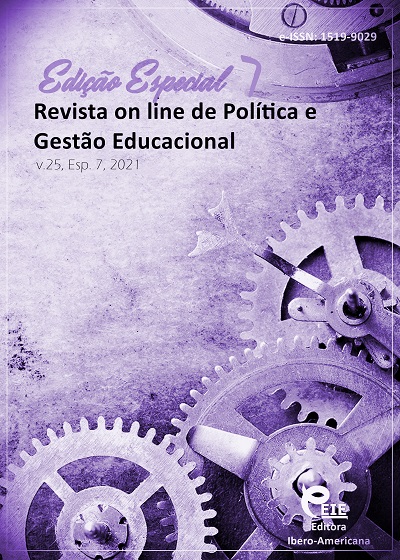Opiniones de los estudiantes sobre la educación en matemáticas en línea, sugerencias para mejorar la calidad de la educación durante la pandemia del Covid-19
DOI:
https://doi.org/10.22633/rpge.v25iesp.7.17389Palabras clave:
Educación a distancia, Educación matemática, Estudiante, Uso de tecnologia, Opiniones sobre la educación en líneaResumen
El estudio tiene como objetivo determinar las opiniones de los estudiantes sobre la enseñanza de las matemáticas en línea y obtener sus sugerencias para mejorar. Los participantes fueron 125 estudiantes que cursaron estudios en 25 departamentos diferentes de diferentes facultades de una universidad privada durante el curso académico 2020-2021. En la investigación se utiliza el modelo de patrón mixto cuantitativo-cualitativo. Se creó un formulario en línea en Google Forms y se envió a los estudiantes. En este formulario, hubo algunas preguntas sobre su sexo, edad, departamentos que estudiaron en la escuela secundaria, departamentos en los que se inscribieron actualmente y 10 preguntas relacionadas con la investigación. Los participantes hicieron muchas opiniones positivas y negativas sobre la educación matemática en línea. Las respuestas dadas por los participantes a las preguntas fueron examinadas en tablas separadas y analizadas según los departamentos que egresaron de la escuela secundaria (ponderados numérica y verbalmente).
Descargas
Citas
AKDEMIR, Ö.; BIÇER, D.; PARMAKSIZ, R. Ş. Information and Communications Technology Metaphors. Mediterranean Journal of Social & Behavioral Research, v. 4, n. 1, p. 11-18, 2020. DOI: 10.30935/mjosbr/9596.
ALMANTHARI, A.; MAULINA, S.; BRUCE, S. Secondary school mathematics teachers’ views on E-learning implementation barriers during the COVID-19 pandemic: the case of Indonesia. Eurasia Journal of Mathematics, Science and Technology Education, v. 16, n. 7, em1860, 2020. DOI: .10.29333/ejmste/8240.
CALDWELL, E. R. A comparative study of three instructional modalities in a computer programming course: Traditional instruction, web-based instruction, and online instruction. The University of North Carolina at Greensboro, 2006.
CANDARLI, D.; YUKSEL, H. G. Students’ perceptions of video-conferencing in the classrooms in higher education. Procedia-Social and Behavioral Sciences, v. 47, p. 357-361, 2012.
CHEN, T. et al. Analysis of user satisfaction with online education platforms in China during the COVID-19 pandemic. Healthcare, v. 8, n. 3, p. 200, 2020. DOI: 10.3390/healthcare8030200.
CHIU, T. K. Applying the self-determination theory (SDT) to explain student engagement in online learning during the COVID-19 pandemic. Journal of Research on Technology in Education, p. 1-17, 2021. DOI: 10.1080/15391523.2021.1891998.
DE OLIVEIRA, M. M. S.; PENEDO, A. S. T.; PEREIRA, V. S. Distance education: advantages and disadvantages of the point of view of education and society. Dialogia, n. 29, p. 139-152, 2018.
GALLIGAN, L. et al. The use of tablet and related. 2010.
GÜRER, M.; TEKINARSLAN, E.; YAVUZALP, N. Opinions of instructors who give lectures online about distance education. Turkish Online Journal of Qualitative Inquiry, v. 7, n. 1, p. 47-78, 2016.
INAN, F. et al. The impact of self-regulation strategies on student success and satisfaction in an online course. International Journal on E-learning, v. 16, n. 1, p. 23-32, 2017.
JONES, D. Computing by distance education: Problems and solutions. ACM SIGCSE Bulletin, v. 28, n. SI, p. 139-146, 1996.
LEE, Y.; CHOI, J. A review of online course dropout research: Implications for practice and future research. Educational Technology Research and Development, v. 59, n. 5, p. 593-618, 2011.
PAPADOPOULOS, P. M. et al. The value of writing-to-learn when using question prompts to support web-based learning in ill-structured domains. Educational Technology Research and Development, v. 59, n. 1, p. 71-90, 2011.
SARIKAYA, H.; YARIMSAKALLI, M. S. The students’ view for teaching numerical analysis in the form of distance education. World Journal on Educational Technology: Current Issues, v. 12, n. 4, p. 348-360, 2020.
SILVERMAN, D.; DATA, I. Q. Methods for analysing talk, text and interaction. 2001.
TAMAH, S. M.; TRIWIDAYATI, K. R.; UTAMI, T. S. D. Secondary school language teachers’ online learning engagement during the COVID-19 pandemic in Indonesia. Journal of Information Technology Education: Research, v. 19, p. 803-832, 2020. DOI: 10.28945/4626.
TONBULOĞLU, B.; GÜROL, A. Analysis of distance education students’opinions and satisfaction levels of their programs. European Journal of Open Education and E-learning Studies, 2016.
Publicado
Cómo citar
Número
Sección
Licencia
Derechos de autor 2021 Revista on line de Política e Gestão Educacional

Esta obra está bajo una licencia internacional Creative Commons Atribución-NoComercial-CompartirIgual 4.0.
Manuscritos aceitos e publicados são de propriedade da Revista on line de Política e Gestão Educacional. É vedada a submissão integral ou parcial do manuscrito a qualquer outro periódico. A responsabilidade do conteúdo dos artigos é exclusiva dos autores. É vedada a tradução para outro idioma sem a autorização escrita do Editor ouvida a Comissão Editorial Científica.











